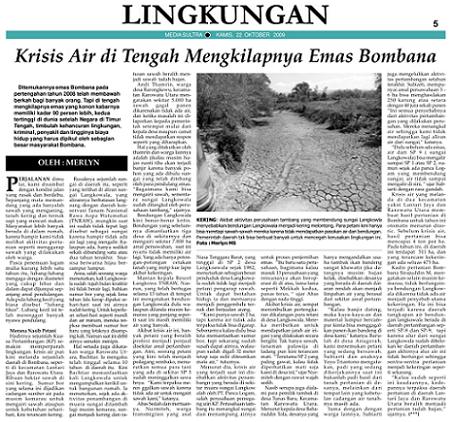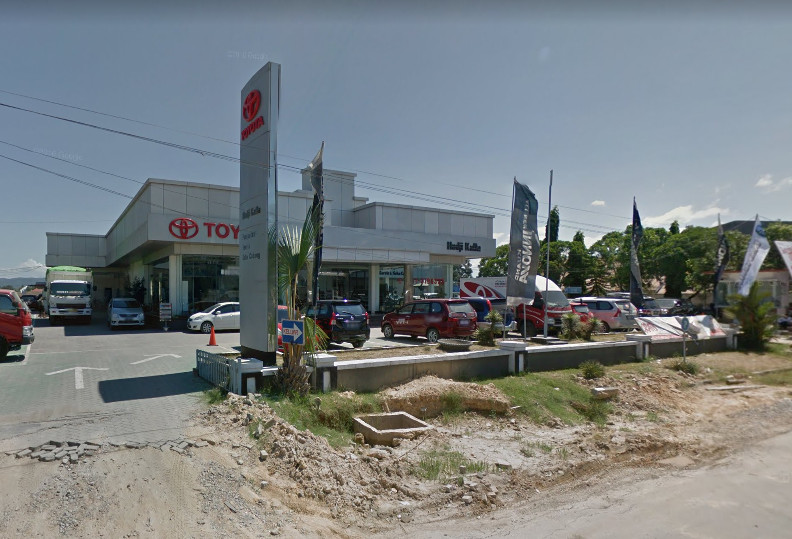Benefits ripple outwards but local government struggles to regulate the process
In 2008, Bombana District of Southeast Sulawesi in eastern Indonesia experienced a dramatic influx of artisanal miners following the chance discovery of alluvial gold in the uplands of the Tahe Ite and, later, Langkowala rivers. As stories of the golden bounty spread, a flood of prospectors arrived in the area – some local, many of them opportunistic, temporary migrants from other regions of Indonesia – and began working the alluvial gold fields within the river systems. In months, there was said to be a ‘sea of people’ (lautan manusia) streaming into the area as thousands of hastily constructed prospecting camps sprung up along fifteen kilometres of the main channel of the Tahi Ite River and then expanded into other areas. At its peak, an estimated 60,000 people were issued local panning licenses. The governor at the time declared the bounty a sign of the grace and blessing of Allah.
Gold fever
One of the recurrent features of new gold discoveries, both globally and over the course of human history, is the phenomenon of the booming gold rush where increasing numbers of people are attracted to the gold fields in search of fast money and easy fortunes. At this early stage, relatively abundant amounts of gold can be extracted from river beds and gold-bearing deposits, which attracts even larger numbers of prospective miners.
The frenzied stage of artisanal mining may be sustained over a number of years before the returns on effort start to decline, shallow deposits are mined out and attention shifts to rumours of new discoveries elsewhere, or the industry becomes more regulated and formalised as larger companies take over. This is the pattern of the 2008–2012 mining boom in Bombana and in many other areas of Indonesia. The experience exemplified, over its brief but exuberant lifespan, both the extraordinary benefits that ripple outwards from the centre of mining activity, but also the significant constraints on local government to implement effective regulatory policies and overall management of the process.
Direct and indirect beneficiaries
The great influx of miners into the Bombana goldfields produced two immediate and related economic effects. Firstly, it generated substantial quantities of alluvial gold that could be immediately traded for cash, and hence large amounts of discretionary income. Secondly, the pressure of demand on existing local facilities and services created sustained price inflation and many unprecedented business opportunities to service the spontaneous and expanding mining settlements.
This combination of impacts produced two categories of beneficiaries. The first group is those directly and actively involved in the mining itself: hydraulic sluicing, panning alluvium, tunnelling for ore, processing the gold fines and mercury amalgam, as well as gold trading itself. Young men remain especially prominent in this workforce, drawn by dreams of riches and the risky nature of the work. But the second group was a very much larger and diffuse population of people who benefitted indirectly through provisioning goods and services in the mining shanty towns and camps. It is this highly diverse group of opportunistic providers that generates the multiplier effect which draws ever greater numbers of participants into the process.
Servicing miners
In Bombana, the bulk of artisanal mining was focussed on the thinly populated upper river catchments. As the tents and makeshift shelters mushroomed across the landscape, there was a surging demand for all manner of services and supplies. Those with an entrepreneurial bent responded by providing a bewildering array of goods and services; new hotels and restaurants opened, shopkeepers and traders delivered tents and tarpaulins, ropes, tools and building supplies, generators, pumps, lamps, bedding, clothing, cooking pots and cutlery, cosmetics and toiletries. There were many start-up sole operators who began mobile services driving trucks and motorbikes into the mining areas, selling all manner of foodstuffs: vegetables, fresh meat, dry goods, prepared meals (nasi and mie bungkus, bakso, bubur ayam and more). In the absence of infrastructure such as water and sanitation facilities, sales of fresh water became a lucrative business, as did trade in petrol and diesel fuel by privateers selling at heavily marked up prices. Mobile phone marketing and phone credit sellers, hairdressing salons, welding and mechanical repair shops, carpenters and mini-pharmacies all flourished. Security services also thrived in response to the inevitable emergence of hustlers, thieves and standover tactics on the lightly regulated gold fields.
Spreading good fortune
Beyond the mining camps, local market-based traders and farmers enjoyed increased sales. So did providers of recreation and leisure pursuits, such as karaoke clubs, drinking venues and other more personalised services, all too happy to relieve cashed-up customers of their windfall earnings. Much of this business was organised and enjoyed by local Bombana residents, many of whom had abandoned their usual farming occupations in favour of chancing their hand in the new economic landscape.
But at the height of the boom in 2009–2010, the scale of activity attracted sellers and traders from much wider afield. For example, many businesses in the provincial capital, Kendari (100 kilometres north of Bombana), saw significantly increased sales. Car dealers shipped out dozens of vehicles. Toyota Hilux was a popular brand as one of the few 4WD pick-ups that could navigate the muddy, churned up tracks on the goldfields, while heavy equipment suppliers from as far afield as Kolaka and Makassar (South Sulawesi) found lucrative new markets. Even medical practitioners benefited from the stream of young miners presenting with skin rashes and other complaints due to the physical hazards of alluvial mining and contamination from unprotected mercury use.

A locally-based online newsletter laments the water crisis amid the 2008 gold rush. Reckless mining created physical hazards in Bombana. (Merlyn)
In short, the Bombana gold rush was an unprecedented period of economic profit-taking and good fortune for thousands of resident households, businesses and local entrepreneurs in Southeast Sulawesi. In these circumstances, it would have taken a courageous district head or another elected official who was willing to enforce planning and environmental controls to clamp down on illegal activity and collusion.
Arguably, the weight of public interest prevented any concerted and swift attempts by government to do so. Even if the extreme impact from mining was reduced over time by more measured efforts to regulate the goldfields, such as through limited company concessions, many locals still recall favourably the heady days of ‘booming gold’ and the instant wealth it generated. Now they blame the government for the decline in their fortunes, the exit of miners to more prospective goldfields and a return to more normalised and lower income livelihoods.
Not everyone benefits
Not everyone benefitted from the gold rush in Bombana, of course. Mercury contamination and massive erosion led to high levels of river water turbidity, heavy sedimentation and localised flooding in the main waterways. These impacts are destructive, environmental legacies for affected farmers, fishers and multiple downstream communities. But for those who took advantage of the financial opportunities presented by the boom – including the local government, which benefitted from overall increases in investment, economic activity and taxes – mining did indeed provide a gold rush, one that was largely irresistible to those who called for a more measured, environmentally sustainable and regulated process.
Multiplier effects
Multiplier effects of the gold rush in Bombana and similar situations elsewhere generate comparatively massive short-term gains and large returns on investment. Local populations are typically major beneficiaries, along with politically influential investors, dealers and local politicians. For these reasons it seems inevitable that the negative impacts of unregulated artisanal mining in Indonesia, in this case alluvial gold mining, will always tend to be downplayed, accommodated or neglected during the initial destructive and critical phases because of the widespread and highly attractive financial rewards it delivers.
Andrew McWilliam (A.McWilliam@westernsydney.edu.au) is a professor of anthropology at Western Sydney University.












